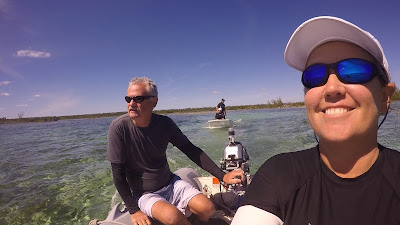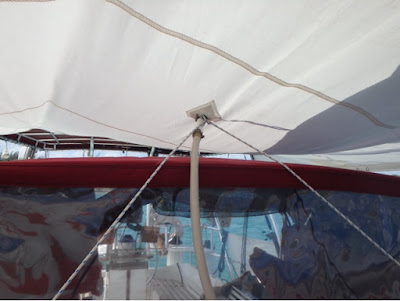
 You wake up in the morning, look out the window at the white stuff that the local plow driver just pushed into your driveway, curse, grab a coffee, scratch your um… head and turn on the TV to the weather station verifying whats been and whats coming for the weather that day. We do the sailors version of channel surfing weather. Most mornings we listen to Chris Parker, check weather on the internet, then listen to the Cruisers Net. For those that haven’t experienced a cruisers net, a net is a bunch of dedicate people who share the local weather, advertise local events and businesses flog their wares to cruisers, translation, they brag about food and drink. By far Marc’s and my favorite ad is Brian from Done Rovin advertising for Petes Pub Little Harbour, by day five of listening I could mimic his booming voice followed by my morning giggle…“the Island you can drive to, home of the world famous Blaster, why walk when you can crawl, where the elite eat in their bare feet” He had me hook line and sinker, I had to go see Pete’s Pub Little Harbour
You wake up in the morning, look out the window at the white stuff that the local plow driver just pushed into your driveway, curse, grab a coffee, scratch your um… head and turn on the TV to the weather station verifying whats been and whats coming for the weather that day. We do the sailors version of channel surfing weather. Most mornings we listen to Chris Parker, check weather on the internet, then listen to the Cruisers Net. For those that haven’t experienced a cruisers net, a net is a bunch of dedicate people who share the local weather, advertise local events and businesses flog their wares to cruisers, translation, they brag about food and drink. By far Marc’s and my favorite ad is Brian from Done Rovin advertising for Petes Pub Little Harbour, by day five of listening I could mimic his booming voice followed by my morning giggle…“the Island you can drive to, home of the world famous Blaster, why walk when you can crawl, where the elite eat in their bare feet” He had me hook line and sinker, I had to go see Pete’s Pub Little Harbour
Marc and I have now made two, week long visits to Little Harbour, for us its a cruisers paradise. The much talked about entrance, shallow at low tide, had plenty of water for DevOcean’s 5’2” keel at half tide. The Picturesque Harbour is sheltered on all sides and promptly on grabbing a mooring ball, we were greeted by a manatee and we all know manatee’s and dolphins are good luck.
We enjoyed our first visit with the fantastic buddy boat Kirsten & Rocky of the S/V Night Music, the weather was sunny, winds were light which made exploring perfect. I think Kirsten and I walked miles of beach, snorkelled hours in the water, and the four us of drank more than a few cups of Blasters. We were entertained by the Remoras and nurse sharks under the boat, fished in Robinson’s bight, and excitedly we were given a tour of the foundry from Richard Appaldo, Sculpture Ran Johnston's last student in 1983.
Anyway before I got side tracked I was telling you we got a tour of the foundry.
The process used is called the lost wax bronze casting method, A wax model is encased in a heat-resistant material like plaster. Then it is heated so that the mold hardens and the wax melts. The remaining cavity, a negative image of the model, is then filled with molten metal. The surrounding cover is removed after it cools, revealing a solid metal object in the image of the original model. The artwork can then be polished or painted. It's a complex and sometimes dangerous process, involving molten metal and twelve stages, each with ample room for error. A piece can take three months to finish. These bronze works are found all over the world, including the Vatican.

 Sadly, we were running out of water, so we had to leave. When the wind started to blow again about ten days later we jumped at the opportunity to head back to Little Harbour. This time we tucked in close to avoid swell, and wait out the blow. We spent windy days walking the beach, collecting sea glass, hiking Bookies Beach, then…explored THE CAVE. Richard told us that a scientist explored the cave and had dated owls dating back 100’s of years. With the added draw of owls and history I was hooked. Though fascinating as any open air caves are time has obscured this one, sadly the presence of bats, owls and wildlife is absent. Of course I always had my imagination to in vision Mrs. Johnson raising her children in the cave. People often ask how we spend our days on the boat, everyday chores we take for granted like laundry, water and groceries are all day tasks. Can you imagine, the 1950’s four kids, no fresh water source, living in a cave? Kids being kids, climbing, swimming, playing. Seems like a perfect adventure to me.
Sadly, we were running out of water, so we had to leave. When the wind started to blow again about ten days later we jumped at the opportunity to head back to Little Harbour. This time we tucked in close to avoid swell, and wait out the blow. We spent windy days walking the beach, collecting sea glass, hiking Bookies Beach, then…explored THE CAVE. Richard told us that a scientist explored the cave and had dated owls dating back 100’s of years. With the added draw of owls and history I was hooked. Though fascinating as any open air caves are time has obscured this one, sadly the presence of bats, owls and wildlife is absent. Of course I always had my imagination to in vision Mrs. Johnson raising her children in the cave. People often ask how we spend our days on the boat, everyday chores we take for granted like laundry, water and groceries are all day tasks. Can you imagine, the 1950’s four kids, no fresh water source, living in a cave? Kids being kids, climbing, swimming, playing. Seems like a perfect adventure to me.
About 40 homes have been built at Little Harbour since Randolph Johnston sailed in, moved out of a cave and into a house himself. Before that, the only stucture was a small lighthouse. "There is no sign of man except the distant roof of the Little Harbour Light.” Johnson wrote in his Log. The remains of the lighthouse, its roof finally blown off by Floyd, can be reached via a path which starts from the shoreline and winds up the hill through seagrapes and bush.
So what about Pete’s Pub? There’s nothing fancy about Pete’s, as its sand floor and roof constructed of colorful t-shirts and flags will attest, but it was perfect, the staff welcoming, food delicious, blasters a treat.
There are so many corny expressions here I could fill this page…
"It's not a topless bar," the pub has a roof. "It's more of a sideless saloon.”
“If you have on shoes your over dressed”
So, Brian you enticed us to Pete’s Pub with your booming voice and funny slogans and we stayed because we fell in love with Little Harbour.














































